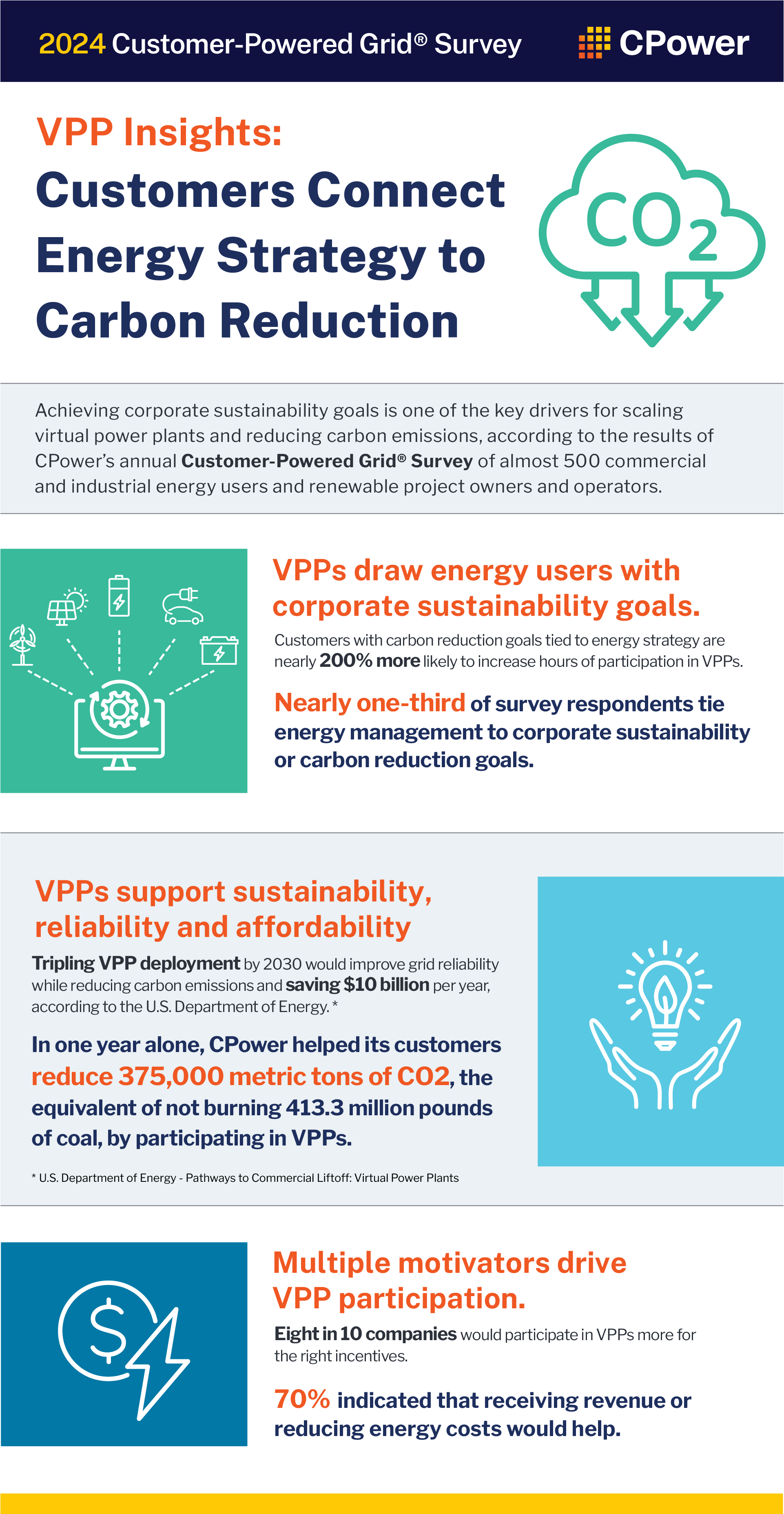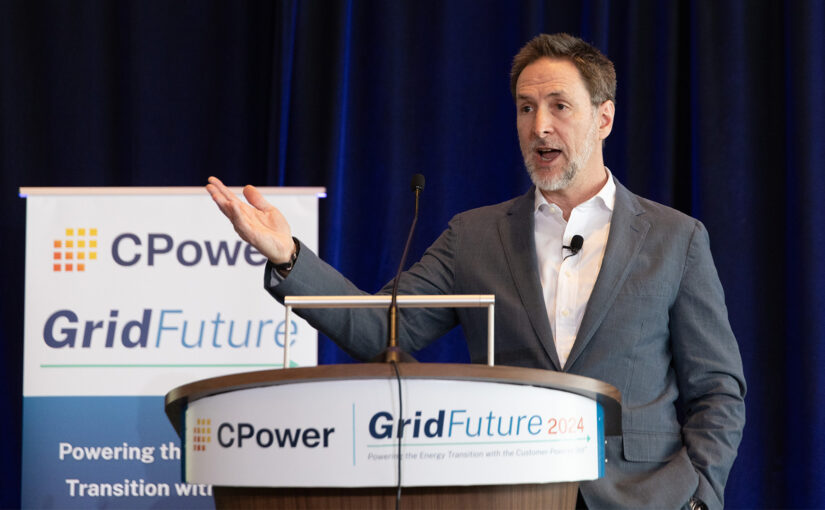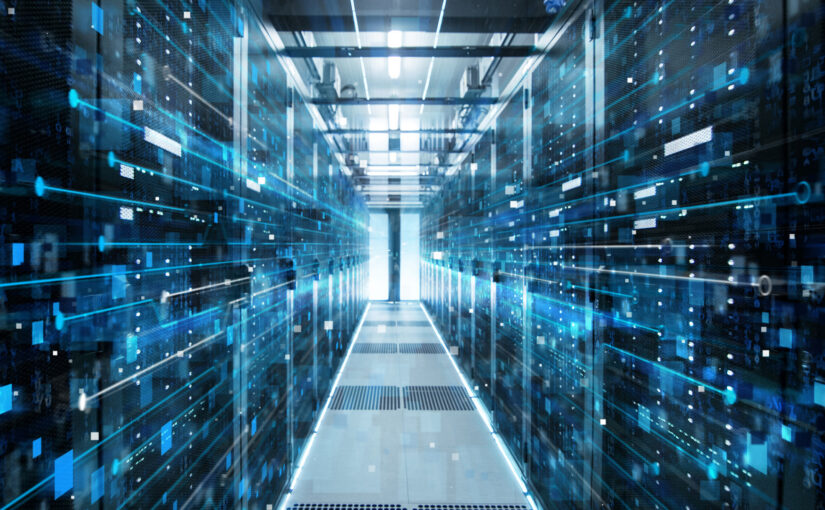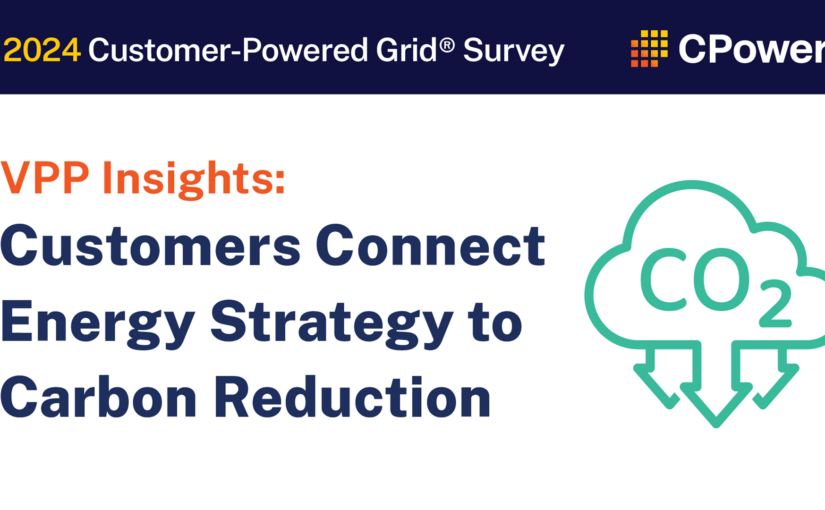Why wait? VPPs can help PJM now

This article first appeared on Utility Dive on Aug. 14, 2024. Click here to view.
Even though PJM’s capacity prices hit record highs for 2025-26, they could go even higher or remain elevated unless the grid operator’s generation capacity can catch up with its surging demand.
PJM Interconnection’s record-high capacity prices for next year may send a build signal to generators, but the nation’s largest grid operator needs more supply to meet accelerating demand growth now — and virtual power plants can help.
A cheaper and faster-to-market alternative than building generation, VPPs use existing distributed energy resources, including batteries, EVs, smart thermostats and other controllable devices and loads, to keep the lights on when the grid is stressed. In aggregating customer DERs and dispatching them together as VPPs, we can quickly and affordably balance the grid today, without the lengthy waits and large investments needed to build physical power plants.
Costly problem
PJM attributed its sharp increase in capacity prices — from $28.92/MW-day for 2024/2025 to $269.92/MW-day for 2025/26 — to generator retirements, increased electricity demand and market reforms, while some market observers put the onus on the grid operator. Advanced Energy United, for one, blamed poor planning and insufficient electric transmission build-out by PJM.
Whatever the cause, the challenge is real. Not only are generation resources retiring faster than their capacity is being replaced, but the projected peak load is rising, due largely to AI, data centers and EVs. In addition, the market is adapting to Federal Energy Regulatory Commission-approved regulations for improved reliability risk modeling for extreme weather and accreditation that more accurately values each resource’s contribution to reliability.
With multiple factors in play and no way to bring enough new generation online in the short term to ensure grid reliability in PJM’s next delivery year, we have little choice but to consider alternatives such as VPPs, which we can quickly stand up without building physical infrastructure, or which are located on the distribution system and can be connected sooner than through the PJM process.
Proven solution
While PJM has not avoided VPPs, it could do more with them, beginning by using demand response more than it does now. A key component in VPPs, demand response accounted for only 5% of the capacity that PJM has secured for next year, despite its dependability and history of improving grid reliability.
After all, it has not yet been two years since VPPs including demand response helped keep the lights on in PJM amidst widespread failures in its generation fleet. During Winter Storm Elliott in December 2022, reducing usage and keeping load down was key to avoiding blackouts. Almost a quarter of the grid operator’s generation capacity — 47,000 MW — was on forced outages at one point when temperatures plunged during the Christmas weekend.
Long a linchpin of grid operators’ handling of peak summer loads, demand response has become a year-round solution as extreme weather events like Winter Storm Elliott have become more common and severe. With a history of handling summer heatwaves as well as winter storms, demand response is critical to ensuring a reliable grid, according to a report about grid reliability challenges co-published by Wood Mackenzie and CPower. Thus, demand response should play a greater role in PJM’s capacity markets.
Energy efficiency
PJM should similarly embrace energy efficiency, contrary to recent efforts to end its participation in the grid operator’s capacity market. Like demand response, energy efficiency is an essential part of VPPs.
The grid operator’s independent market monitor, or IMM, filed a FERC complaint in July regarding energy efficiency in PJM. The IMM wrongly argued that “PJM has been paying the capacity market clearing price to EE resources that do not meet the definition of an EE Resource,” and therefore that PJM should stop payments to resources that allegedly do not meet its criteria for energy efficiency. Further, IMM urges that EE providers (and by implication, customers) should be forced to return past payments that PJM previously approved.
Not only is the IMM’s argument contrary to PJM’s approved tariff, but it is also wrong economically. PJM’s sharply higher capacity prices for 2025/26 clearly demonstrate the need for more diversification of resources in the market, not less.
Reliable future
Even though PJM’s capacity prices hit record highs for 2025/26, they could go even higher or remain elevated unless the grid operator’s generation capacity can catch up with its surging demand.
The 8.9% decline in total capacity offered by non-energy efficiency resources in PJM’s latest capacity auction, from 148,945.7 MW in 2024/2025 to 135,692.3 MW in 2025/2026, marked the fourth consecutive year-over-year drop. Meanwhile, the peak load forecast increased by 2.2% to 153,883 MW, and the grid operator’s overall reserve margin shrunk by almost two full percentage points, from 20.4% to 18.5%.
With a total cost to load of $14.7 billion for the next delivery year due to tighter supply relative to demand, customers in PJM can ill afford to be stuck with another big bill for capacity. Yet, they may well face a double whammy with the 2026/27 capacity auction set for December. Exelon has already warned of double-digit rate increases for some of its utility subsidiaries due to the results for 2025/26.
PJM has stated that much of the struggle to bring new generation online is beyond its control, noting that 38,000 MW of resources have cleared its interconnection queue but have not been built due to external challenges, including financing, supply chain and siting/permitting issues. Thus, even if PJM has more generation capacity in 2026 than in 2025, it will not be enough to bring prices down dramatically.
So, with great time and expense needed, even if generators react to the build signal sent by the recently released capacity prices for 2025/26, not enough will be built anytime soon. Therefore, the best solution, and perhaps the only one, is to quickly scale up VPPs that include demand response and energy efficiency resources.
We may need more power generation resources, but nothing says those resources must be large, central station grid-scale power plants. Sometimes smaller and more distributed is better.
PJM Capacity Prices Prove Need for VPPs

The sharp increase in PJM capacity prices for the grid operator’s next delivery year demonstrates the value of balancing supply and demand with existing resources.
Rising more than 800%, PJM capacity prices have reached record highs as North America’s largest wholesale electricity market grapples with tightening supply and escalating demand. Generator capacity is being retired faster than it is replaced, and demand growth is accelerating as electricity usage surges for artificial intelligence, data centers and electric vehicles.
Fortunately, we can quickly and affordably balance the grid today without the lengthy waits and large investments needed to build physical power plants. Virtual power plants (VPPs) that include grid services like demand response can supply capacity now by aggregating distributed energy resources (DERs) and dispatching them together.
VPPs offer a cheaper and faster-to-market alternative because they use existing, low-cost DERs, including batteries, EVs, smart thermostats and other controllable devices and loads, to keep the lights on when the grid is stressed. If we were to triple the current scale of VPPs in the U.S. to 80-160 GW by 2030, as the U.S. Department of Energy hopes, we could reliably support load growth such as that in PJM while avoiding $10 billion in annual grid costs.
VPPs Help the Grid
PJM’s total cost to load for 2025/26 is $14.7 billion, given that capacity prices rose to $269.92/MW-day from $28.92/MW-day for 2024/2025. The grid operator attributed the sharp increase to generator retirements, increased electricity demand and market reforms, including Federal Energy Regulatory Commission (FERC)-approved regulations for improved reliability risk modeling for extreme weather and accreditation that more accurately values each resource’s contribution to reliability.
Such factors are not limited to PJM. Grid operators across the country struggle to balance supply and demand, particularly during critical conditions like extreme weather.
For example, in its 2024 Summer Reliability Assessment, the North American Electric Reliability Corporation warned that markets served by the Midcontinent Independent System Operator (MISO), ISO New England and Electric Reliability Council of Texas (ERCOT) could face summer electricity shortages in extreme summer conditions. When pressed in such instances, grid operators and utilities can use flexible customer DERs for handling grid disruptions.
With extreme weather such as heatwaves increasingly severe and frequent, VPPs can multiply the benefits of DERs by aggregating and dispatching them across types, customers and locations. VPPs including demand response have proved to be a reliable resource during grid emergencies year-round.
Customers Benefit from VPPs
VPPs also provide value for energy users who help the grid with their DERs. Customers can earn revenue, reduce energy costs and help the environment.
There are increasingly more opportunities for customers to benefit, and the potential rewards are growing as well. While grid operators have long relied on large energy users like commercial and industrial customers to reduce their loads during emergency conditions by paying them to participate in capacity markets, today’s grid must adapt to shifts in supply or demand more frequently and quickly to remain balanced and avoid blackouts.
This increasing need for flexibility shows up in all services that grid operators now use—including energy, capacity, ancillary services and bespoke programs. Although ancillary services alone rarely make economic sense for customers, once they’re participating in capacity, it often makes sense to add on ancillary services to increase rewards.
Flexible participation programs require customers to react more frequently than in the emergency capacity markets, but they can earn additional revenue streams by participating. Industries with larger, more flexible loads are particularly well suited to earning more money from flexible participation.
For example, big-box retailers with multiple sites in multiple states can widely help the grid with their flexible loads, like by adjusting their lighting or HVAC systems without interrupting operations or inconveniencing customers or employees.
Flexible interruptible computing loads are also valuable, including those for data centers, crypto miners and AI loads. Whatever the industry, the most flexible of demand response programs reward customers with more revenue for curtailing their resources in reaction to grid needs in seconds, not hours.
So, while capacity prices in PJM surge and other grip operators similarly struggle to balance rapidly changing supply and demand, existing customer DERs can efficiently improve grid reliability. Embracing VPPs saves money for grid operators, provides revenue for customers and delivers clean, affordable and more reliable energy for all.
To learn more about VPPs and how CPower can help you monetize your energy assets while supporting sustainability, improving grid reliability and increasing energy resiliency, call us at 844-276-9371 or visit CPowerEnergy.com/contact.
VPPs and CPower: Q&A with CEO Michael D. Smith

CEO Michael D. Smith knew CPower was a leading enabler of the energy transition when he took the helm a year ago, but he has since learned the extent of that role.
As the nation’s largest virtual power plant (VPP) provider, CPower boosts grid reliability while helping customers unlock the full value of their distributed energy resources (DERs). In aggregating DERs and dispatching them as VPPs, CPower helps customers earn revenue and reduce energy spending by providing services that grid operators need to avoid blackouts. Grid operators pay energy users to help keep the grid balanced, like by using less electricity or supplying power from distributed generation.
Smith has been a leading proponent of VPPs since he became CPower’s CEO in July 2023, broadening awareness of how energy users, particularly commercial and industrial customers and DER Project Owners and Developers, can help the grid transition to clean energy—and be rewarded for doing so.
A year after his first interview with The Current, Smith reflected on how far CPower and VPPs have come and discussed where they are going.
1. The Current: What has surprised you most about your first year at CPower?
Smith: One is the complexity of the industry. Not being a veteran of demand response and virtual power plants, it was eye-opening to learn how complex of a proposition it is to simplify grid services for our customers and make it easy for them to interact with the power grid.
Secondly, every customer is unique, and we must customize our approach accordingly. They each have their own operating parameters and concerns about how participating in a VPP might impact those operating parameters.
For example, if a customer has a large industrial load that powers their operations, you don’t want to impact the industrial process that is their lifeblood. You must work with them to figure out ways to be responsive to grid dispatch without disrupting their core processes.
We’re good at working with each customer to put them in programs consistent with their unique operating characteristics. We know the particulars of the different industries we serve and the needs of the individual customers within those industries.
One big-box retailer may differ from another, for example, in terms of what their motivations are and what they can and cannot do. Industrials will differ from a college campus. So, having those one-on-one relationships with customers is hugely important. That’s our secret sauce.
2. The Current: What are some memorable moments that have stood out to you over the past year?
Smith: GridFuture was a great milestone for us. Not just because we were looking inward and bringing all our employees together for the first time in four years, but also the outward-facing nature of the event with the inclusion of the U.S. Department of Energy, LS Power and its portfolio companies, our customers and our partners. It made for a fantastic event whose benefits were two-fold.
Internally, there was the engagement of the 200 employees that participated. They were excited to be with their peers and talk about their business and where the industry is headed.
Externally, it validated our ability to attract outside thought leaders who are important to our business and have an interest in our industry. That says a lot about the CPower brand and the interest in the growing importance of VPPs in helping the grid.
And although GridFuture was one of the most memorable moments, it has been one of many enjoyable experiences getting to know the CPower team. Our monthly ‘Get CPowered Days’ in Baltimore have been a great way to bring everyone together on a regular basis.
Many of our employees work remotely or out of offices other than our headquarters in Baltimore. Frequently bringing distributed team members together has fostered face-to-face interactions and relationship building that have further boosted employee engagement, which is vital. We can’t expect to provide world-class service to our customers and our grid partners if we don’t have a highly engaged workforce.
3. The Current: A year ago, you spoke about how the industry was evolving, particularly regarding how the physicality of the electric grid was changing as more customers generated their own energy. Has this trend evolved and how is CPower addressing it?
Smith: The single biggest trend in the energy markets right now is load growth. We’re coming out of approximately 10 years without significant growth in demand. In fact, in some regions of the country, demand shrunk, particularly during COVID.
Now, we’re seeing demand grow rapidly, and it’s in large part because of the participation of some key commercial organizations including data centers, crypto miners and companies that are tapping into artificial intelligence. Computing, mining and all the data that is being used for AI are creating macro growth in overall load, especially in burgeoning data center hubs like Ohio, Illinois and Virginia.
These energy users can also come online much quicker than new power plants can be built. That creates a supply-demand imbalance and that’s what we solve.
We give the grid operators much more efficient and effective tools to manage supply-demand imbalance than building new power plants and associated transmission lines.
Also, in addition to supporting grid stability in an era of demand growth, we support further electrification of buildings and vehicle fleets, and the deployment of on-site renewable generation and energy storage.
All these macro trends point to the need for VPPs, and we support them by being good at connecting our customers’ capabilities with the grid’s needs. It’s why we’ve successfully managed a 40% increase in dispatches YoY to help rescue the grid when it has been needed the most.
4. The Current: What is flexible participation? And why does it matter to grid operators and customers?
Smith: Our bread-and-butter is a capacity product where the grid pays us, and therefore our customers, to be available in times of grid stress. Grid operators rely on our customers to reduce their loads during emergency conditions.
However, grid needs have changed and continue to do so. Grid operators need much more help than just asking commercial and industrial customers to conserve electricity during emergencies like peaks in summer electricity demands.
Compounding factors drive a greater need for grid flexibility to smooth the energy transition, including issues such as retiring fossil-fuel generators, more wind and solar generation, accelerating vehicle electrification and more extreme weather events.
With all these factors in play, the grid must adapt to shifts in supply or demand more quickly and frequently to keep them balanced and avoid blackouts. This increasing need for flexibility shows up in all the products and programs grid operators use to ensure the system remains in balance—including energy, capacity, ancillary services and bespoke programs.
We offer flexible programs where customers can get paid to provide energy to the grid in times of need. That could be in response to an energy price signal or to support shorter disturbances to help stabilize the grid, like a car’s shock absorber.
Flexible participation is taking part in those energy and ancillary services programs. Customers generally need to be able to react more quickly than in emergency capacity programs.
Flexible participation programs also need customers to be able to react more frequently than in the emergency capacity markets, but they can earn additional revenue streams by participating.
Although any business or organization that has a box with lights, air conditioning and electricity going to it can be part of our virtual power plants, some industries have larger, more flexible loads that can be more useful to grid operators and more rewarding for customers.
For example, we talked about interruptible computing, which includes data centers, crypto and AI customers that have flexible loads. Big-box retailers with multiple sites in multiple states also have a lot of flexibility in their loads, particularly for adjusting their lighting or HVAC systems without interrupting operations or inconveniencing customers or employees. They have a huge opportunity to help the grid.
5. The Current: Let’s look into your crystal ball for a moment. Any predictions for CPower or the industry ahead?
Smith: The industry itself will continue to grow and we will continue to grow along with it as the need for grid flexibility increases and the benefits of VPPs multiply.
According to the U.S. Department of Energy, deploying 80-160 GW of VPPs—tripling current scale—by 2030 could expand the U.S. grid’s capacity to reliably support a ~60 GW rise in coincident peak demand while avoiding $10 billion in annual grid costs. Other research shows that relying on customer-sited DERs that make up VPPs is up to 60% more cost-effective than using gas power plants.
VPPs can also be created quickly by tapping existing resources. They will only become more common and expansive as grid operators realize that they typically take less than a year to stand up and customers see that they can start receiving the benefits of participating shortly thereafter.
As the demand for VPPs rises, CPower and its customers will be there to meet it.
To learn more about VPPs and how CPower can help you monetize your energy assets while supporting sustainability, improving grid reliability and increasing energy resiliency, call us at 844-276-9371 or visit CPowerEnergy.com/contact.
VPPs and Flexible Demand Response: Bitcoin Mining Flexes its Capabilities
 We’re excited to have our technology partner, Auradine contribute this guest column for The Current.
We’re excited to have our technology partner, Auradine contribute this guest column for The Current.
In an era of continuously rising energy consumption, the need for efficient and sustainable energy management solutions has never been more critical. Demand response programs, particularly those that require extreme flexibility and near instantaneous reactions from energy users, are emerging as pivotal components in modern energy systems because they offer a dynamic method to balance supply and demand, enhance grid stability, and promote energy efficiency.
Interestingly, Bitcoin mining, traditionally seen as an energy-intensive process, is an integral part of this initiative. The Bitcoin miners at the center of the almost-immediate-response evolution are earning revenue, reducing costs, and helping the power grid by taking advantage of energy providers’ most flexible demand response programs through a combination of cutting-edge, innovative technologies and collaborations with virtual power plant (VPP) providers.
Rapid demand response relies on energy systems’ capability to adjust real-time consumption patterns based on supply conditions. Unlike traditional demand response involving scheduled adjustments, more flexible demand response leverages advanced technologies to provide instantaneous feedback and actions. This capability is essential for integrating renewable energy sources, managing peak demand and ensuring grid reliability.
According to the International Energy Agency (IEA), demand response is vital in modern energy systems because it reduces the need for additional generation capacity, avoids greenhouse gas emissions, and provides economic benefits by optimizing energy usage. The IEA emphasizes the importance of integrating demand response into energy efficiency strategies to achieve a sustainable energy future.
Bitcoin Mining: A Leader in Flexible Demand Response
Although Bitcoin mining, the process of validating transactions and securing the Bitcoin blockchain through complex mathematical computations, has been scrutinized for its significant energy consumption, its flexibility and high responsiveness to energy availability make it ideal for the most flexible of demand response programs, which reward customers with more revenue for curtailing their resources in reaction to grid needs in seconds, not hours.
Unlike in many other industries, Bitcoin mining operations can be swiftly adjusted or paused in response to grid signals, thus providing a unique form of demand response. During periods of excess energy supply, Bitcoin miners can ramp up operations to consume surplus electricity that would otherwise go to waste. Conversely, mining activities can be scaled back or halted during peak demand periods, freeing up energy for other uses.
Auradine’s EnergyTune™ technology is at the forefront of integrating Bitcoin mining into the fastest-acting demand response framework. This advanced system utilizes machine learning algorithms and real-time data analytics to optimize energy consumption for Bitcoin mining. EnergyTune™ can seamlessly adjust power usage in response to grid signals within seconds.
Bitcoin miners can dynamically adjust their computational power based on real-time grid conditions. This ensures that mining activities are conducted during periods of low energy demand or high renewable energy availability, thereby minimizing the environmental impact and improving overall energy efficiency.
VPP providers such as CPower Energy are essential partners in the flexible demand response ecosystem for Bitcoin mining. In aggregating distributed energy resources (DERs), such as solar panels, batteries, and flexible loads, that can be dispatched as needed, VPPs provide reliable and scalable demand response services.
CPower, for instance, leverages its extensive network of DERs to offer near-real-time demand response solutions. By integrating with technologies like EnergyTune™, CPower can optimize the performance of its VPPs, thereby ensuring that energy resources are utilized efficiently and effectively. This collaboration enables a more resilient and adaptive energy system capable of rapidly responding to fluctuations in supply and demand.
Benefits of Rapid Demand Response
During periods of high energy demand, miners can reduce or halt their operations, selling their allocated energy back to the grid at premium rates. During low demand or excess renewable energy supply periods, miners can capitalize on cheaper electricity costs to maximize their mining activities. This dual capability not only enhances the profitability of Bitcoin mining but also contributes to grid stability and efficiency, creating a symbiotic relationship between energy providers and miners. |
The Path Forward for Flexible Demand Response and VPPs
Flexible demand response programs requiring rapid customer reactions are poised to be pivotal in transforming energy management. By integrating Bitcoin mining into the framework for rapid demand response and leveraging technologies such as Auradine’s EnergyTune™, the energy sector can achieve greater efficiency, stability, and sustainability. Collaboration with VPP providers such as CPower further underscores the potential to revolutionize the energy landscape.
A coordinated approach involving all stakeholders is essential for realizing demand response’s full potential. The most flexible demand response programs, in particular, can lead the way to a more resilient and adaptive energy future through continued innovation and collaboration—and Bitcoin mining is doing its part.
Summer Electricity Demand: A Region-by-Region Outlook

Calendars may show that summer didn’t start until June 20, but thermometers across the country in the past few weeks have suggested otherwise. From heat domes in the Southwest to record-high temperatures in the Northeast, summer electricity needs kicked in early—and grid operators are bracing for another few hot months.
Although grid operators and federal regulators expect to have enough resource capacity to weather a typically hot summer, some parts of the U.S. are at risk of power shortages if the mercury shoots higher and stays there longer.
Markets served by the Midcontinent Independent System Operator (MISO), ISO New England and Electric Reliability Council of Texas (ERCOT) could face summer electricity shortages in extreme summer conditions, according to the North American Electric Reliability Corp. (NERC) 2024 Summer Reliability Assessment.
NERC has recommended that at-risk areas take precautions such as reviewing seasonal operating plans and protocols for communicating and resolving potential supply shortfalls. It has also noted that many assessment areas have expanded demand-side management programs to give grid operators more resources to reduce electricity demand if it exceeds supply.
When temperatures spike, grid operators could turn to energy users to help keep the lights on in communities. If they do, customers that make their distributed energy resources (DERs) available to grid operators as virtual power plants (VPPs) could benefit as a result.
In aggregating customer DERs and dispatching them together, VPPs are an effective and cost-efficient way to quickly balance the grid. So, they could be a go-to resource for grid operators with resource adequacy concerns this summer.
Here’s what grid operators and regulators project the summer’s electricity needs to look like so far.

Source: North American Electric Reliability Corp. (NERC) 2024 Summer Reliability Assessment.
Summer Electricity Outlook by Market
Click on one of the markets below to go directly to that section.
California Independent System Operator (CAISO)
The California Independent System Operator (CAISO) has a positive Summer Outlook for 2024 due to several factors.
-
- A total of 9,071 MW of capacity is expected to have been added to the state’s grid since Sept. 1 or to go online by June 30.
- Average conditions for producing hydropower and a softening of the summer 2024 load forecast peak demand should more than offset generator retirements.
- Although weather forecasts show an increased chance of above-normal temperatures across interior California, there is less likelihood of higher-than-usual temperatures in coastal areas, especially Southern California.
After considering all factors, CAISO expects to have sufficient resources to meet forecasted demand plus an 18.5% reserve margin for all summer months in 2024. It also anticipates a surplus of at least 3,438 MW over forecasted demand plus the 18.5% reserve margin during peak net load hours of 6 p.m. to 10 p.m. in September.
Emergency Programs in Place
However, CAISO has also warned that “extreme drought, wildfires and continued potential for widespread heat events and other disruptions continue to pose a risk for emergency conditions to the ISO grid.” Therefore, the ISO is preparing strategic reserves and emergency programs for this summer.
California demand response programs that could be called upon include the Emergency Load Reduction Program (ELRP) and Demand Side Grid Support (DSGS) Program. ELRP pays energy users for reducing consumption during grid emergencies and DSGS incentivizes electric customers to provide load reduction and backup generation when extreme events occur, like heatwaves.
DSGS is a new program meant to prevent summer power outages, specifically between May and October. It is part of California’s Strategic Reliability Reserve, a suite of programs to alleviate tight energy supplies on the grid caused by heatwaves, wildfires and other ongoing impacts of climate change.
through eligible providers like demand response aggregators. Participating customers can receive payments for help such as reducing load, putting combustion resources on standby or providing remotely controllable generation like backup generators powered by biomethane, natural gas or diesel.
Electric Reliability Council of Texas (ERCOT)
NERC has warned that the Electric Reliability Council of Texas (ERCOT) market could be at risk of power outages due to a decrease in available generation. Conventional generation resources like fossil-fueled power plants are being retired and the state is increasingly dependent on variable energy resources.
Risk is highest during off-peak or net-peak hours in areas dependent on renewables, like solar or wind generation, NERC has noted. With solar and wind accounting for growing shares of the state’s generation mix, ERCOT must replace renewable energy that is not available when the sun does not shine, or the wind does not blow.
“Continued robust growth in both loads and intermittent renewable resources has elevated the risk of emergency conditions in the evening hours when solar generation begins to ramp down,” according to NERC’s summer reliability assessment. “ERCOT’s probabilistic risk assessment indicates an elevated risk of having to declare [energy emergencies] during hours ending 8:00–9:00 p.m. Central on the August peak load day.”
The risk could rise further if ERCOT needs to limit power transfers from South Texas into the San Antonio region when demand peaks. Demand could overload the lines that make up the South Texas export and import interfaces, necessitating South Texas generation curtailments and potential firm load shedding to avoid cascading outages. “The risk is greatest when ERCOT has extremely high net loads in the early evening hours,” NERC noted.
So, even though ERCOT expects to have sufficient resources to meet operating reserve requirements for the peak demand hour scenario, NERC noted that there is risk of supply shortages as solar generation ramps down during the early evening hours when system load is high and transmission constraints limit transfers.
According to NERC, ERCOT expects to have nearly 3,500 MW of demand response resources available this summer, the equivalent of 4% of normal peak demand. ERCOT and utilities offer demand response programs for Texas energy users.
The ERCOT Contingency Reserve Service (ECRS) is the grid operator’s newest demand response program. Available in 2024, the new ERCS program is like the LR program in that resources must respond within 10 minutes of being dispatched. They must also sustain their performance for “as long as they have the responsibility to provide this service.”
ISO New England (ISO-NE)
New England’s grid operator, ISO-NE, anticipates meeting peak demand for electricity this summer. Assuming typical weather conditions. ISO-NE predicts electricity demand will reach 24,553 megawatts (MW).
However, above-average summer weather, such as an extended heat wave coupled with high humidity, could push demand up to 26,383 MW. This could tighten supply margins because the ISO anticipates having about 30,000 MW of capacity available to meet demand and required reserves.
ISO-NE will have less capacity this summer than last because two natural gas-fired generators (with a total summer capacity of 1,400 MW) were retired in May. “This makes it more likely that ISO New England will need to resort to operating procedures for obtaining resources or non-firm supplies from neighboring areas during periods of above-normal peak demand or low-resource conditions. Summer heat waves that extend over the entire area can limit the availability of excess supplies and increase the risk of energy emergencies in New England,” NERC noted in its summer reliability assessment.
ISO-NE has stated that system operators have numerous tools to balance load, including increasing production of online generation or dispatching stand-by units and energy conservation such as voluntary reductions of energy use.
The grid operator anticipates having 3,891 MW of demand resources for its 2024/2025 Capacity Commitment Period, according to the 2024 Summer Energy Market and Electric Reliability Assessment from the Federal Energy Regulatory Commission (FERC).
In worst-case circumstances, ISO-NE could be forced to call for controlled power outages to maintain system reliability and safeguard the infrastructure of the grid. “With the possibility of more extreme and less predictable weather conditions, there is an increased potential for system operators to activate emergency procedures,” ISO-NE stated in a press release.
ISO-NE and utilities in the region offer demand response programs in New England.
Midcontinent Independent System Operator (MISO)
MISO projects sufficient capacity under probable demand, but would rely on load-modifying resources (LMRs) made available through demand response programs and operating reserves to meet a high-demand scenario. Should a high-demand scenario materialize, MISO would be at an elevated risk of operating reserve shortfalls, NERC noted.
According to MISO, its surplus of 4,624 MW remains adequate for normal conditions, even though surplus capacity has decreased 30% since last summer, due largely to generator retirement, increased planning reserve margin requirement (PRMR) and fewer external offers. Regarding transmission, the grid operator says it is well-positioned to handle unplanned events on the MISO system this summer.
Furthermore, MISO has stated that it would mitigate summer risks by leveraging lessons learned from previous heatwaves, such as how appropriately timed use of LMRs and an increased requirement for its 30-minute reserve product worked well. MISO also expects solar generation to play a more active role as its in-service capacity tops 6 GW over the summer.
Demand Response Programs Available
Should MISO need LMRs, it could turn to demand response programs available to commercial and industrial customers in parts of Illinois and Michigan. Michigan customers served by Consumers Energy, DTE Energy or select municipal and cooperative members in MISO Zone 7, which covers the Lower Peninsula of Michigan, can participate. In Illinois, demand response participation is open to customers served by Ameren Illinois or select municipal and cooperative members.
Illinois is also trying to create more value from distributed energy resources (DERs) by exploring how utilities can maximize their benefits through effective system planning and efficient operational control. Regulators are considering a two-pronged approach to compensation for components of DER value such as benefits to energy and capacity markets and ancillary services.
New York Independent System Operator (NYISO)
The New York Independent System Operator (NYISO) does not anticipate any operational issues in the state this summer. It projects having adequate capacity margins and has procedures in place to handle any issues that may occur. For example, the grid operator could use demand response to meet above-normal summer peak load, NERC noted.
Although NYISO expects to have 40,733 MW of power resources available to meet forecasted peak demand conditions of 33,301 MW, the grid operator has warned that reliability concerns remain. Demand peaked at 30,206 MW last summer.
“Reliability margins have declined by more than 1,000 megawatts in just the last two years. That’s a significant issue especially when we’re impacted by heatwaves,” Executive Vice President and Chief Operating Officer Emilie Nelson stated in a press release announcing NYISO’s outlook for summer electricity reliability. “As demand is forecasted to rise in the coming years, this trend will continue to pose a challenge to system reliability.”
The reliability margin for this summer is 752 MW under baseline conditions but would be deficient during extreme weather. For example, if the state experiences a heatwave with an average daily temperature of 95 degrees lasting 3 or more days, the capacity margin is forecasted to be -1,419 MW, NYISO noted.
The margin would worsen to -3,093 MW under an extreme heatwave with an average daily temperature of 98 degrees. Under those conditions, NYISO operators would dispatch up to 3,275 MW through emergency operating procedures to maintain reliability, the grid operator has stated.
Demand Response Programs for Large Energy Users
Demand response has been at the forefront of NYISO’s efforts to smooth the state’s transition to clean energy. For example, NYISO has paved the way for virtual power plants (VPPs) by implementing its DER & AggregationParticipation Model, which was the country’s first program to integrate aggregations of distributed energy resources (DERs) into wholesale markets.
The DER Participation Model enables DERs to provide energy, ancillary services and capacity in the NYISO markets. DERs of at least 10 kW aggregated into VPPs of at least 100 kW can simultaneously provide wholesale services to the grid operator and retail services to utilities and load servers.
DER aggregations can include resources such as demand response, solar arrays, batteries and electric vehicles. Curtailable load, or demand response, is the only type of DER that can be aggregated as a single resource and technology. Currently, many C&I customers earn substantial revenue and reduce energy costs by participating in demand response in New York,
PJM
With a forecasted installed reserve margin of 29%, including expected committed demand response, versus a target of 17.7%, PJM does not any anticipate any problems meeting demand this summer, NERC noted. However, the grid operator does expect reserve margins to be lower than last summer due to rising demand, generator retirements and slower-than-anticipated resource additions.
The loss of generation resources is outpacing the addition of replacement resources amid accelerating growth in consumers’ demand for electricity, PJM stated in its summer outlook announcement. Thus, the grid operator has fewer generation resources (182,500 MW) of installed capacity) to draw on this summer compared with 2023 (186,500 MW of installed capacity).
PJM also projects a higher peak demand for electricity this summer at approximately 151,000 MW compared with the 2023 summer peak load of 147,000 MW. The increased peak load forecast combined with reduced generating capacity reduces reserve margins for extreme weather scenarios.
Scenarios that include this higher level of demand, combined with low solar and wind output and/or high generator outages, would further reduce reserve margins, the grid operator has noted. In these “unlikely but possible set of circumstances,” it might have to implement additional procedures to manage emergencies, including dispatching demand response, calling for conservation, limiting electricity exports or even temporarily interrupting service, according to PJM.
PJM has several demand response programs that it could call upon for help.
With the summer’s heat already here, and more to come in the months ahead, grid operators are preparing to meet surging demand. And as summer electricity usage surges, grid operators will likely seek help from customers that make their DERs available as VPPs. Customers who help will be rewarded.
CPower makes DER monetization easier and more rewarding by using customer resources to strengthen the grid when and where reliable, dispatchable resources are needed most. Customers interested in earning grid services revenue and reducing energy costs by helping grid operators meet their summer electricity needs can contact CPower to learn more: cpowerenergy.com/contact/.
Industrial Energy
Sustainability Goals Spur Virtual Power Plant Projects

Large energy users view virtual power plant projects as ways to help the environment. We could accelerate a cleaner and greener future by harnessing that motivation.
The percentage of commercial and industrial (C&I) customers that use distributed energy resources (DERs) as virtual power plants (VPPs) with the environment in mind has gradually increased over the last few years, according to CPower’s annual Customer-Powered Grid® Survey. Nearly one-third (31%) of organizations now connect their energy management strategy to corporate sustainability or carbon reduction goals, this year’s survey showed.
Achieving environmental goals is increasingly important both for companies and their executives. Six in 10 companies from the S&P Composite 1500 Index include environmental, social and governance (ESG) metrics in measuring CEO performance—nearly triple the 23% that did in 2019
Furthermore, the percentage of S&P 500 companies with a climate metric in their incentive plan has climbed to almost 45%, up from 14% three years ago, representatives from WTW, formerly known as Willis Towers Watson, stated in a recent webinar, according to ESG Dive.
Customers help the environment when they use DERs like small-scale solar arrays, batteries or curtailable load because grid operators avoid burning fossil fuels and emitting associated carbon to generate electricity. In using DERs as VPPs in this way, grid operators save money as customers earn revenue and help their communities by avoiding carbon emissions.
Curtailing load or switching to renewable generation is particularly beneficial for customers, grid operators and communities when demand on the grid peaks. Rather than turning on polluting peaker plants to supply more power to the grid, grid operators pay C&I customers to reduce their electric loads.
Reducing Carbon Emissions with Virtual Power Plants
C&I customers with carbon reduction goals tied to energy strategy are nearly 200% more likely to increase hours of participation in VPPs, according to CPower’s 2024 Customer-Powered Grid® Survey, which drew approximately 500 responses from customers, DER owners and operators and partners.
In one year alone, CPower helped its customers reduce 375,000 metric tons of CO2 by using their VPPs as DERs, across sectors such as retail, data centers, education, healthcare, government and manufacturing. CPower manages nearly 7 GW of flexible DER capacity nationwide, which is equivalent to not turning on 134 peaker plants when demand cannot meet supply.
In addition to embracing the environmental impact of reducing carbon, customers appreciate the financial benefits of VPPs. Eight of 10 survey respondents said they would likely increase their participation in VPPs if the right incentives were in place. When asked to clarify what type of incentives would motivate them, 70% indicated that receiving revenue or reducing energy costs would help.
Understanding the drivers of VPP participation, like the environmental and financial benefits, is vital to meeting the U.S. Department of Energy’s target to triple VPP deployment by 2030, which would improve grid reliability while reducing carbon emissions and saving an estimated $10 billion per year.
Knowing that customers value helping the environment through virtual power plant projects can help us reach the DOE’s goal. If we encourage more C&I energy users to embrace the environmental benefits of VPP, we can help them achieve their goals —while also bringing about the cleaner and greener future that we endeavor to create.
To learn more about how virtual power plant projects can help your organization achieve its corporate sustainability or carbon reduction goals, call us at 844-276-9371 or visit CPowerEnergy.com/contact.
How One Midwest State Aims to Create More Value from Distributed Energy
 If states are to fully unlock the value of distributed energy resources (DERs), utilities will have to pay customers for all the grid services they can provide with their DERs.
If states are to fully unlock the value of distributed energy resources (DERs), utilities will have to pay customers for all the grid services they can provide with their DERs.
Regulators in states such as Illinois are exploring how to calculate the value of DERs so that utilities can maximize their benefits through effective system planning and efficient operational control. Such effectiveness and efficiency are often lacking in current state policies, but the opportunity to unlock value for both the grid and customers can and should be taken.
“Although utility-scale assets benefit from economies of scale and lower levelized costs, by virtue of their proximity to demand, distributed energy resources (DERs) can provide unique system benefits (e.g., reduced losses, congestion, and curtailment, and deferred infrastructure investment) and thus higher value per kilowatt-hour (kWh) generated. However, many of these benefits are not fully incorporated into electricity markets or compensation structures,” wrote the authors of a research paper about DER value that was published in Energy Policy.
Investigating DER Value and Compensation in Illinois
In Illinois, regulators are considering a two-pronged approach to compensation for components of DER value such as benefits to energy and capacity markets and ancillary services.
Enacted in 2021, the state’s Climate and Equitable Jobs Act (CEJA) required the Illinois Commerce Commission (ICC) to initiate an investigation into the value of, and compensation for, DERs by no later than June 30, 2023, which the ICC did last year. The ICC has held several related workshops since August 2023.
The Commission has been identifying the various components of DER value and which are compensated. It has also been considering whether DERs can provide additive services and determining the terms and conditions for such services.
In a March 2024 workshop, the ICC began developing a framework for calculating and compensating DER value and working towards a strawman model for DER valuation. The Commission’s goals in designing the framework include fairly compensating DERs for their value, making it simple for customers to understand their compensation, allowing utilities to administer the framework without burdensome cost and complexity, and enabling the framework to be updated annually with consistent results.
Although the ICC is mandated to formulate a base rebate specific to distributed generation, the development of a compensation mechanism for additive services is encouraged but not technically mandated by the statute.
As a result, since the additive services portion of the law is not a required output of the Commission’s implementation of CEJA, there is a risk that it may not receive the attention it deserves. That outcome would not only be a mistake, but it would also be a gigantic, missed opportunity that would hurt Illinois customers.
If regulators do not develop compensation for additive services, the state’s utilities will not get the full value of DERs because customers will not be incentivized to help the grid by providing much-needed flexibility services.
Vast latent resource potential exists today amongst customers who have inherent flexibility in the way they use electricity. That vitally important and valuable potential is growing every day and should be leveraged to assist in distribution system planning and operation. Therefore, it is critically important that regulators develop the state’s base rebate in tandem with additive services compensation.
The base rebate would incentivize the development of distributed generation like solar photovoltaic systems, batteries, wind turbines and electric vehicles, while additive services payments would compensate customers for helping the grid with their DERs. Examples of additive services could include using DERs to respond to distribution system emergencies, managing distribution congestion or deferring investments in distribution infrastructure.
CPower presented suggestions for valuing additive DER services to the ICC at a November 2023 workshop.
Capturing the Value of DERs
The additive services available through DERs correlate with their multiple value streams at multiple levels.
For example, DERs improve reliability by helping grid operators avoid outages when the grid is stressed, and energy prices are high. They also mitigate increases in energy prices by eliminating the need to buy extra electricity.
Furthermore, DERs provide flexibility that helps grid operators balance the grid with operating reserves or regulation programs at the wholesale level or relieve congestion in distribution flows at the distribution level. Grid operators can also defer investments in transmission or distribution infrastructure and avoid burning fossil fuels to bring on peaker plants when the grid is stressed, which helps the environment by avoiding carbon emissions.
While some of these benefits, like those in reliability and flexibility, might be more obvious than others, they all provide value to the grid and should be compensated accordingly. Customers can be compensated at different levels, like by either a wholesale market operator or a utility, to avoid double counting.
Multiplying Grid Services
Distribution programs sometimes conflict with wholesale markets. If the programs are incompatible, customers would have to decide which to enroll their DERs in to avoid simultaneous participation, and therefore double compensation.
Regulators should account for compatibility when designing programs so that customers can participate at multiple levels, and thereby generate multiple value streams. States would then reap the full stream of benefits at both the distribution and wholesale levels.
New York is at the forefront of such layered dynamic load management programs, which increase benefits for customers and grid operators while guarding against double payments for the same MW of grid service.
Customers in New York can extract the full value of their electricity load because they provide distinct grid services across different levels. Perhaps most notably, New York customers can participate in both the Distribution of Load Relief Program (DLRP) and Commercial System Relief Program (CSRP).
Both the DLRP and CSRP programs provide seasonal payments for load curtailment, but they meet different distribution needs. The DLRP program is more emergency-based, while the CSRP is more about delaying infrastructure investments.
Both programs allow for participation in PJM programs because the PJM programs compensate for capacity, while the DLRP and CSRP programs do not. So, there is no issue of double compensation.
With 15 years of harmonious participation by New York customers, the DLRP and CSRP programs offer an example of what Illinois and other states could do in adopting and compensating additive services.
Paying for Grid Services
Lastly, when it comes to incentivizing grid services, paying customers directly for lending their DERs is the most effective motivation for getting energy users to help. Although some states use rebates or bill credits, direct payments work best for compensation because they create more flexibility for customers and encourage broader participation in grid services programs.
For example, if Illinois were to use direct payments to participants for both the base rebate and additive DER services, customers would be more willing to deploy DERs because they could get third-party help in financing projects. DER developers would be more likely to finance projects for energy users in exchange for a steady stream of income from direct payments.
Similarly, customers could use aggregators like CPower to monetize DER assets. This would also encourage broader participation because aggregators make it easier for customers to benefit from helping the grid.
Rules for grid services programs are complex and customers are often not as attuned to the specifics as an aggregator. An aggregator can simplify participation and increase returns by navigating program complexities on a customer’s behalf.
Additionally, by participating through aggregators, customers’ risk of penalties for non-performance is largely taken on by the aggregator, since the aggregator absorbs the penalties and manages its portfolio of customers to minimize or eliminate the expenses.
On the utility side, aggregators eliminate the need to build out the capability of working directly with customers, thereby saving money. This would be particularly true in Illinois, where there is a competitive market for aggregators. There would be no shortage of aggregators willing to step in and connect customers to utilities for grid services.
Illinois and other states can further increase the benefits that DERs provide, particularly in reliability, by leveraging additional DER services through aggregators that collectively dispatch energy resources owned by different customers to help balance the grid. In properly compensating customers for the value of their DERs, regulators will smooth the transition to a clean, flexible, and dependable energy future.
Call us at 844-276-9371 or visit CPowerEnergy.com/contact to explore how you can monetize your DERs and earn revenue for helping the grid.
Everything You Need to Know About New York’s New DER & Aggregation Participation Model

The New York Independent System Operator (NYISO)’s new DER & Aggregation Participation Model reflects how far distributed energy resources (DERs) have come as well as the potential they can unlock as the Empire State drives toward its Reforming the Energy Vision (REV) initiative for creating a more diversified grid by better integrating customers.
Not only has the state’s grid operator acknowledged the collective power of DERs aggregated into virtual power plants (VPPs), but it has also launched the country’s first program to integrate aggregations of DERs into wholesale markets in sync with an effort to create New York’s grid of the future.
As the first registered aggregator for the DER Model and a contributor to the state’s efforts to shape its future grid, CPower sees four key takeaways in how NYISO’s new program improves grid reliability.
NYISO’s DER Model:
1. Benefits commercial and industrial customers.
Commercial and industrial (C&I) customers that can quickly provide grid services can earn additional revenue and save more money by helping NYISO keep the grid balanced. Energy users with automated technology are particularly well positioned because NYISO incentivizes customers to respond to a request for help within minutes.
The DER Model provides market opportunities for C&I energy users by letting them access existing markets as if they were a power plant. For example, customers can access capacity, energy and ancillary service markets under the relevant rules for each. Most of these markets were previously available through other mechanisms, but not all. Until now, these users have had no opportunity to access NYISO’s attractive real-time energy markets. Under the DER Model, they will.
Customers participating in fast-acting demand response for the first time will do so under the new model while NYISO phases out its existing Demand Side Ancillary Service Program (DSASP) for demand response customers. NYISO offers a DER Onboarding Suite for customers interested in participating in the grid operator’s markets.
2. Differs from the DSASP program.
Customers now enrolled in DSASP can remain in the program until it sunsets on April 16, 2025. They will then have to provide grid services through the DER Model if they would like to participate in NYISO markets similarly to how they have done.
Unlike the DSASP program that it replaces for new customers, the DER Model does not confine customers to a single, economic-based demand response program. While DSASP gives energy users the opportunity to offer load reduction into New York’s electricity markets to meet reliability needs, the DER Model allows customers to provide an array of wholesale programs simultaneously.
3. Taps the power of VPPs.
This landmark program unlocks the full benefits of VPPs for the resiliency and reliability of the grid, while also creating new revenue opportunities for commercial and industrial energy users and DER owners and developers. DERs of at least 10 kW aggregated into VPPs of at least 100 kW can simultaneously provide wholesale services to the grid operator and retail services to utilities and load servers.
DER aggregations can include resources such as small-scale solar arrays, batteries and electric vehicles, per market rules approved by the Federal Energy Regulatory Commission (FERC). Curtailable load, or demand response, is the only type of DER that can be aggregated as a single resource and technology.
Leveraging the flexibility of such DERs is essential to achieving New York’s clean energy goals. In its DER Model announcement, NYISO forecasts distributed generation in the state to roughly double over the next three decades as the state strives to have 70% of its electricity generated by renewable resources by 2030 and achieve a 100% clean power grid by 2040. Also, per its REV goals, the state wants to reduce greenhouse gas emissions to 60% of their 1990 levels by 2030 and to just 20% by 2050.
4. Shapes the state’s future grid.
In what was likely a coincidence, New York’s Public Service Commission formally instituted a major, multi-year Grid of the Future proceeding within days of FERC’s approval of the market rules for NYISO’S DER Model.
The Grid of the Future proceeding will dovetail with, and help build upon, the NYISO program by developing a grid flexibility study and plan outlining the current and future potential capabilities of flexible DERs across New York’s electric grid. The study will also identify near-term actions likely to increase the deployment and use of flexible resources and improve integration of flexible resources into grid planning and grid operations.
Just as we helped to drive the process that led to NYISO’S DER Model, CPower will actively participate in the Grid of the Future effort to unlock more opportunities for our customers while helping New York meet its flexibility goals.
Customers interested in earning grid services revenue and reducing energy costs by helping NYISO improve grid flexibility can contact CPower to learn more: cpowerenergy.com/contact/.
Aaron Breidenbaugh | Senior Director, Regulatory and Government Affairs, CPower










